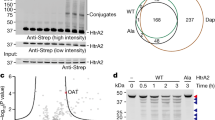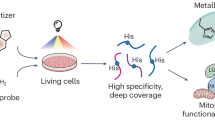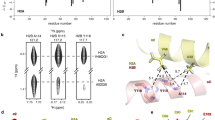Abstract
ISOTOPICALLY labelled histamine ribonucleoside can be detected in the urine of experimental animals after intraperitoneal administration of either 2(ring)−14C-labelled histamine1, or similarly labelled histamine-adenine-dinucleotides2. However, in such experiments the quantities of histamine ribonucleoside recovered from the urine represent only a small percentage of the expected amount. This apparent disappearance of histamine ribonucleoside in vivo suggested the possibility of its combination with proteins. The incorporation of amines into proteins, probably through transamidation, was studied by Waelsch et al.3,4. A similar system, that is, a 100,000g supernatant of a guinea-pig liver homogenate3, was used in our investigations. Histamine ribonucleoside was prepared from histamine adenine dinucleotide phosphate5, as already described2. The degree of purity of this material was checked ionophoretically1,2, and only a single spot was observed in either tris-hydrochloric acid (pH 8.0) or sodium borate (pH 9.1). As shown in Table 1, there was appreciable incorporation of radioactivity into the acid insoluble fraction of the incubation mixtures when either histamine, or histamine ribonucleoside, or histamine-adenine-dinucleotide-phosphate was used. This incorporation was Ca2+-dependent. Thus, in controls from which Ca2+ was omitted, very few scintillations were counted, and radioactivity approached background values (Table 1). When tested under conditions similar to those in Table 1, the guinea-pig liver supernatant used in our investigations was found free of activities capable of liberating inorganic phosphate from the dinucleotide. This may be partly due to the lack of the proper enzymes (that is, pyrophosphatases and phosphatases) and partly because of the lack of magnesium ions. In any event, this finding led us to the conclusion that the dinucleotide was probably attached as such on the protein molecule.
This is a preview of subscription content, access via your institution
Access options
Subscribe to this journal
Receive 51 print issues and online access
$199.00 per year
only $3.90 per issue
Buy this article
- Purchase on SpringerLink
- Instant access to full article PDF
Prices may be subject to local taxes which are calculated during checkout
Similar content being viewed by others
References
Alivisatos, S. G. A., Fed. Proc., 24, 769 (1965).
Alivisatos, S. G. A., Abdel-Latif, A. A., Ungar, F., and Mourkides, G. A., Nature, 199, 907 (1963).
Clarke, D. D., Mycek, M. J., Neidle, A., and Waelsch, H., Arch. Biochem. J. Biophys., 79, 338 (1959).
Mycek, M. J., and Waelsch, H., J. Biol. Chem., 235, 3513 (1960).
Abdel-Latif, A. A., and Alivisatos, S. G. A., J. Biol. Chem., 236, 2710 (1961).
Zeller, E. A., in Metabolic Inhibitors, edit. by Hochster, R. M., and Quastel, J. H., 2, 53 (Academic Press, Inc., New York, 1963).
Alivisatos, S. G. A., in Handbuch d. Exp. Pharmakologie, edit. by Rochae Silva, M., 18, 726 (Springer-Verlag, Heidelberg).
Gornall, A. G., Bardawill, C. J., and David, M. M., J. Biol. Chem., 177, 751 (1951).
Liakopoulou, A., and Alivisatos, S. G. A., J. Biol. Chem., 240, 3110 (1965).
Muraoka, S., Sugiyama, M., and Yamasaki, H., Biochem. Pharmacol., 14, 27 (1965).
Author information
Authors and Affiliations
Rights and permissions
About this article
Cite this article
ALIVISATOS, S., UNGAR, F. & MOURKIDES, G. Incorporation of Histamine Ribonucleoside into Soluble Proteins. Nature 211, 187 (1966). https://doi.org/10.1038/211187a0
Issue Date:
DOI: https://doi.org/10.1038/211187a0



